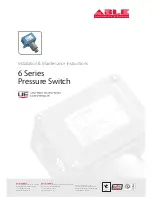
Guard Lock Safety-door Switch
D4JL
S
a
fe
ty D
o
o
r
Sw
it
c
h
e
s
P
recau
ti
on
s f
o
r
All Sa
fe
ty
Do
o
r
Switch
e
s
D4
NS
D4
GS-
N
D
4
BS
D4
G
L
D4
JL
D
4
NL
D4
BL
D4
NH
D
4
0
B
D4
NS-
SK0
1
D4
NS-
SK3
0
D4
J
L
-SK3
0
70
Attaching a Cover
• Make sure the release key is set to the LOCK position before
covering the D4JL.
• Always confirm that the seal rubber has no abnormalities before
using it. The seal rubber will lose its sealing capability if the seal
rubber is out of place or not properly seated, or if foreign material is
adhering to it.
• Use only the correct screw. Using an incorrect screw will reduce the
sealing capability of the seal rubber.
• Use one of the following methods when covering a Trapped Key
Switch.
When the Operation Key is removed (door open):
Cover with the trapped key removed (UNLOCK).
When the Operation Key is inserted (door closed):
Cover with the trapped key inserted (LOCK).
Manual Release
• Manual release is used to unlock the Switch when power cannot be
supplied to the solenoid, such as when power is interrupted or the
equipment is being repaired.
1. Use a Phillips screwdriver to remove the manual release screw.
Use a precision screwdriver to press down the lever inside the
Switch far enough to release the trapped key.
2. The door is unlocked when the trapped key is turned to the
UNLOCK position and removed.
• Do not use manual release to stop machines.
• After the Switch has been manually released, re-install the manual
release screw in its proper position on the Switch using the
specified torque.
Hinged Doors
If the Switch is mounted too close to the hinge, the force imposed on
the lock will be much larger than for locations far from the hinge and
the lock may be damaged. Mount the Switch close to the handle.
Solenoid Lock Models
The solenoid lock locks the door only when power is supplied to the
solenoid. The door will be unlocked if the power supply to the
solenoid stops. Therefore, do not use the solenoid lock models for
machines that may be operating and dangerous even after the
machine stops operating.
Mounting Methods
Tightening Torque
Be sure to tighten each screw of the Switch properly. Loose screws
may result in malfunction.
Switch and Operation Key Mounting
• Mount the Switch and Operation Key securely to the applicable
tightening torque with M5 screws.
• Do not operate the Switch with anything other than the special
OMRON Operation Key. Otherwise, the Switch may be damaged
and the safety of the system may not be maintained.
• Ensure that the alignment offset between the Operation Key and
the key hole does not exceed ±0.8 mm. If the Operation Key is
offset or at an angle, premature wear or damage to the Switch may
result.
• When inserting the Operation Key, install the
provided mounting auxiliary tool in the key hole and
use the tool to position the key in the key hole
center and set zone.
• Remove the mounting auxiliary tool from the
Switch after the Operation Key is properly inserted.
• Observe the specified insertion radius for the Operation Key and
insert it in a direction perpendicular to the key hole.
• Do not impose excessive force on the Key top while the Operation
Key is inserted into the Switch body or drop the Switch with the
Operation Key inserted. Doing either of these may deform the Key
or break the Switch body.
• Attach the enclosed cap head to any Operation Key hole that is not
used.
Securing Doors
When the door is closed (with the Operation Key inserted), it may be
pulled beyond the set zone because of, for example, the door's
weight, or the door cushion rubber.
Use hooks to ensure that the door stays within the set zone.
(1)
(2)
Precision
screwdriver
Type
Tightening torque
Terminal screw
0.6 to 0.8 N·m
Cover mounting screw
0.7 to 0.9 N·m
Manual release screw
0.6 to 0.8 N·m
Operation Key mounting screw 2.4 to 2.8 N·m
Switch mounting screw
3.2 to 3.8 N·m
Connector
1.8 to 2.2 N·m
(excluding 1/2-14NPT)
1.4 to 1.8 N·m (1/2-14NPT)
Cap screw
1.3 to 1.7 N·m
22
±
0.1
Two, M5
Three, M5
Rear release button hole
reference (50 dia.)
50
±
0.1
44.2
±
0.1
43.5
±
0.1
89
±
0.1
23.5
±
0.1
18.5
±
0.1
Mounting Holes for Switches
Mounting Holes for
Operation Keys
Auxiliary
mounting tool
Set zone
(3.3 mm)
Operation Key
0.8
(Auxiliary mounting tool)



































